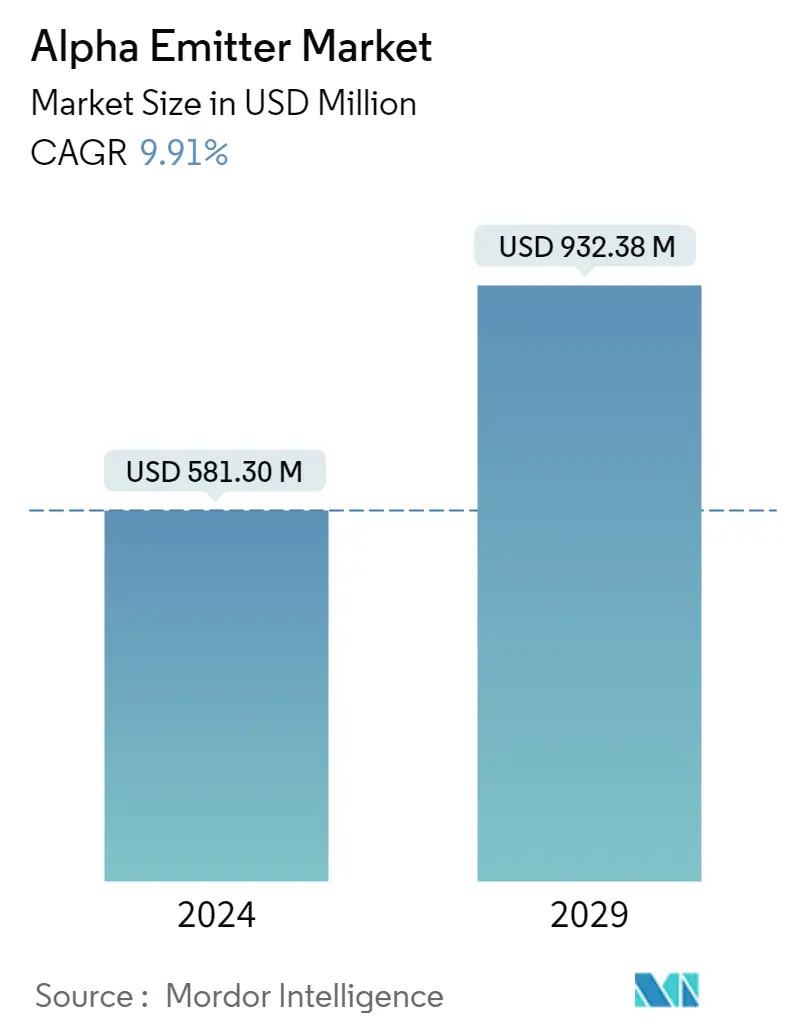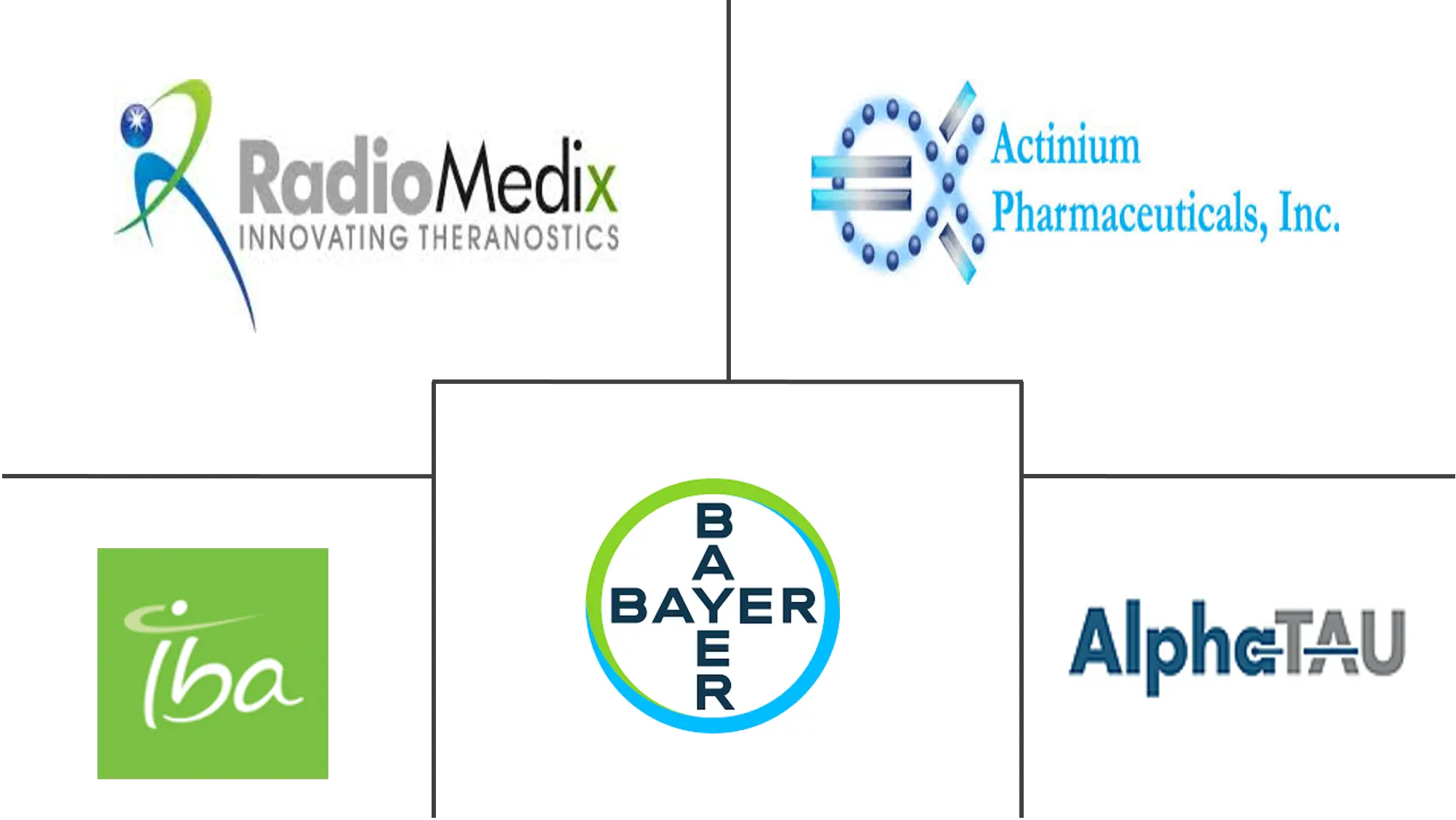Market Size of Alpha Emitter Industry

| Study Period | 2019 - 2029 |
| Market Size (2024) | USD 581.30 Million |
| Market Size (2029) | USD 932.38 Million |
| CAGR (2024 - 2029) | 9.91 % |
| Fastest Growing Market | Asia Pacific |
| Largest Market | North America |
Major Players
*Disclaimer: Major Players sorted in no particular order |
Alpha Emitter Market Analysis
The Alpha Emitter Market size is estimated at USD 581.30 million in 2024, and is expected to reach USD 932.38 million by 2029, growing at a CAGR of 9.91% during the forecast period (2024-2029).
Certain factors that are driving the market growth include increased awareness about the potential benefits of targeted alpha therapy and the growing number of patients with cardiac and cancer ailments.
The global pandemic of COVID-19 is predicted to have an impact on the alpha emitters market. Consequently, the reduced contact with physicians in outpatient consultations in the initial period of the pandemic resulted in a decreased number of patients being referred to nuclear medicine for diagnosis and treatment; this effect being less prominent for oncological patients. During the COVID-19 outbreak, according to a survey published in the PMC Journal in September 2020, a total of 434 responses from 72 countries confirmed a significant reduction in nuclear medicine procedures; more than 50% in diagnostic and 40% in therapeutic procedures. However, as the population has begun to cope with the pandemic, the need for cancer care is expected to boost, which is expected to significantly impact the market.
An increase in awareness of the potential benefits of the targeted alpha emitter and a high number of patients with various types of cancers such as ovarian cancer, pancreatic cancer, lymphoma, and melanoma are likely to boost the market growth. In addition, increasing the use of targeted anticancer or alpha therapy (TAT) in the treatment of cancer and alpha particles has an advantage in targeted therapy because of their exceptionally high cell-killing ability. For instance, according to the International Agency for Research on Cancer (IARC), by 2040, the global burden is projected to increase to 27.5 million active cancer incidents and 16.3 million cancer deaths primarily due to population growth and aging. About 70% of deaths from cancer occur in low- and middle-income countries. Thus, the rising cases of cancer and cardiovascular diseases are expected to surge the demand for radiopharmaceuticals for the treatment of these diseases.
Companies are now increasingly aware of the potential benefits of targeted therapies to treat several chronic ailments. Radioimmunotherapy with short-ranged, high-efficiency α-particles is a striking and promising treatment approach. α-particles have an advantage in targeted therapy due to their exceptionally high cell-killing ability.
However, regulatory requirements pose a hurdle to translational research and clinical investigations. For instance, in the United States, all pharmacologic agents, including diagnostic radiopharmaceuticals and radio therapeutics, undergo regulatory oversight by the FDA. Similarly, radiopharmaceuticals face additional scrutiny and undergo unique regulatory and approval pathways across the world.
Alpha Emitter Industry Segmentation
In therapeutic radiopharmaceuticals, radionuclides with alpha emitters play a significant role in treating cancers. Properties of alpha emitters have led to exert profound differences between this field and other fields of nuclear medicine. Due to their short-range and high LET (deposit energy in a unit length of their pathway), alpha particles have remarkably been considered in medical research. The market report also covers the estimated market sizes and trends for 17 different countries across the major regions globally. The report offers the value (in USD million) for all the above segments.
| Type of Radionuclide | |
| Astatine (At-211) | |
| Radium (Ra-223) | |
| Actinium (Ac-225) | |
| Lead (Pb-212) | |
| Bismuth (Bi-212) | |
| Other Types of Radionuclides |
| Medical Application | |
| Prostate Cancer | |
| Bone Metastasis | |
| Ovarian Cancer | |
| Pancreatic Cancer | |
| Endocrine Tumors | |
| Other Medical Applications |
| Geography | ||||||||
| ||||||||
| ||||||||
| ||||||||
| ||||||||
|
Alpha Emitter Market Size Summary
The alpha emitter market is poised for significant growth over the forecast period, driven by increasing awareness of targeted alpha therapy's benefits and a rising incidence of cancer and cardiovascular diseases. The market is expected to expand as the demand for radiopharmaceuticals grows, particularly in the treatment of various cancers such as ovarian, pancreatic, lymphoma, and melanoma. The use of alpha particles in targeted therapy is gaining traction due to their high cell-killing ability, making them a promising option for treating chronic ailments. Despite the challenges posed by regulatory requirements, which can hinder translational research and clinical investigations, the market is witnessing advancements in radioimmunotherapy and targeted anticancer therapies. The ovarian cancer segment is anticipated to experience robust growth, supported by increasing diagnosis rates and ongoing clinical trials demonstrating the efficacy of alpha emitters in treatment.
North America currently leads the alpha emitter market, with its dominance expected to continue due to the high prevalence of cancer and cardiological diseases in the region. The market is characterized by a limited number of major players, including IBA Radiopharma Solutions, Bayer AG, and Alpha Tau Medical Ltd, who hold substantial market shares. These companies are actively engaged in developing advanced radionuclides and novel therapies to enhance cancer treatment outcomes. The COVID-19 pandemic initially impacted the market by reducing nuclear medicine procedures, but as healthcare systems adapt, the demand for cancer care is anticipated to rise, further propelling market growth. The ongoing clinical developments and strategic partnerships among key players are expected to drive innovation and expand the application of alpha emitters in oncology and other therapeutic areas.
Alpha Emitter Market Size - Table of Contents
-
1. MARKET DYNAMICS
-
1.1 Market Overview
-
1.2 Market Drivers
-
1.2.1 Increased Awareness About the Potential Benefits of Targeted Alpha Therapy
-
1.2.2 Increasing Number of Patients with Cardiac and Cancer Ailments
-
-
1.3 Market Restraints
-
1.3.1 Short Half-life of Radiopharmaceuticals
-
1.3.2 Stringent Regulatory Framework and Reimbursement Issues
-
1.3.3 Need for High Capital Investment
-
-
1.4 Porter's Five Forces Analysis
-
1.4.1 Threat of New Entrants
-
1.4.2 Bargaining Power of Buyers/Consumers
-
1.4.3 Bargaining Power of Suppliers
-
1.4.4 Threat of Substitute Products
-
1.4.5 Intensity of Competitive Rivalry
-
-
-
2. MARKET SEGMENTATION (Market Size by Value - USD million)
-
2.1 Type of Radionuclide
-
2.1.1 Astatine (At-211)
-
2.1.2 Radium (Ra-223)
-
2.1.3 Actinium (Ac-225)
-
2.1.4 Lead (Pb-212)
-
2.1.5 Bismuth (Bi-212)
-
2.1.6 Other Types of Radionuclides
-
-
2.2 Medical Application
-
2.2.1 Prostate Cancer
-
2.2.2 Bone Metastasis
-
2.2.3 Ovarian Cancer
-
2.2.4 Pancreatic Cancer
-
2.2.5 Endocrine Tumors
-
2.2.6 Other Medical Applications
-
-
2.3 Geography
-
2.3.1 North America
-
2.3.1.1 United States
-
2.3.1.2 Canada
-
2.3.1.3 Mexico
-
-
2.3.2 Europe
-
2.3.2.1 Germany
-
2.3.2.2 United Kingdom
-
2.3.2.3 France
-
2.3.2.4 Italy
-
2.3.2.5 Spain
-
2.3.2.6 Rest of Europe
-
-
2.3.3 Asia-Pacific
-
2.3.3.1 China
-
2.3.3.2 Japan
-
2.3.3.3 India
-
2.3.3.4 Australia
-
2.3.3.5 South Korea
-
2.3.3.6 Rest of Asia-Pacific
-
-
2.3.4 Middle-East and Africa
-
2.3.4.1 GCC
-
2.3.4.2 South Africa
-
2.3.4.3 Rest of Middle-East and Africa
-
-
2.3.5 South America
-
2.3.5.1 Brazil
-
2.3.5.2 Argentina
-
2.3.5.3 Rest of South America
-
-
-
Alpha Emitter Market Size FAQs
How big is the Alpha Emitter Market?
The Alpha Emitter Market size is expected to reach USD 581.30 million in 2024 and grow at a CAGR of 9.91% to reach USD 932.38 million by 2029.
What is the current Alpha Emitter Market size?
In 2024, the Alpha Emitter Market size is expected to reach USD 581.30 million.

